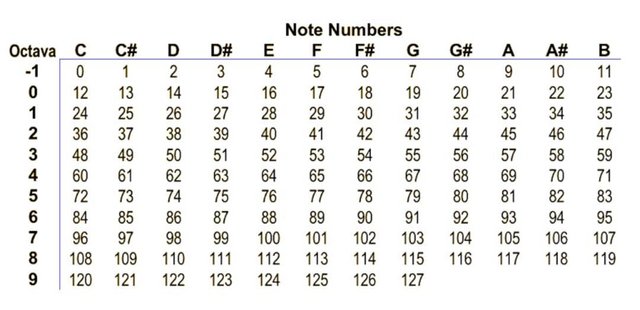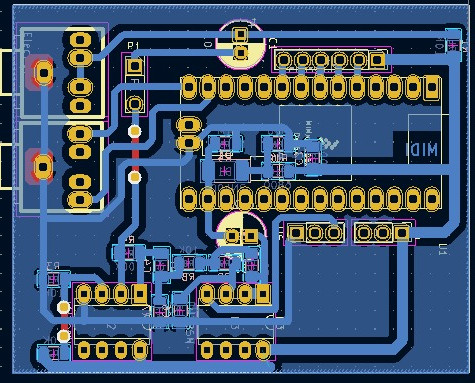The idea of this project originates from an interest on music and trying to find a way to make it easier to record and edit it at the moment. Since me and my teammates enjoy both music and electronics, we decided to go this way and create this project.
The objective of this project is to make the user able to convert real sounds, whether of instruments or voice, into a MIDI format in real time. With MIDI you can put these notes into a music editor, like Reaper, and saw them the while you are playing.
This was made in team with: Joaquin Pimpignano, Iris Martinez, Juan Cruz Martinez and Violeta Martinez.
The most important part of the project. We decide to do it on a teensy because of his memory and fast processment capacity, making posible to create a Fourier Transform for analize the signal and discover the notes in real time.
It tooks the audio and analize it with FFT and a windowing function for making it faster, it returns the dominant frequency.
float Calculate_FFT() {
FFT = arduinoFFT(vReal, vImag, SAMPLES, SAMPLING_FREQ);
FFT.Windowing(FFT_WIN_TYP_HAMMING, FFT_FORWARD);
FFT.Compute(FFT_FORWARD);
FFT.ComplexToMagnitude();
double dominantFrequency = FFT.MajorPeak();
return dominantFrequency;
}
Then, it looks this frequency on a defined array with the corresponding notes for each frequency range.
float NOTES_FREQ[] = { 103.826, 110.000, 116.541, 123.471, 130.813, 138.591, 146.832, 155.563, 164.814, 174.614,
184.997, 195.998, 207.652, 220.000, 233.082, 246.942, 261.626, 277.183, 293.665, 311.127,
329.628, 349.228, 369.994, 391.995, 415.305, 440.000, 466.164, 493.883, 523.251, 554.365,
587.330, 622.254, 659.255, 698.456, 739.989, 783.991, 830.609, 880.000, 932.328, 987.767 };
}
#define MAX_NOTE_FREQ 987.767
#define MIN_NOTE_FREQ 103.826
#define OCTAVES_FITTING 55
float searchForNote(float freq) {
if (freq > MAX_NOTE_FREQ || freq < MIN_NOTE_FREQ) return 0;
for (int i = 1; i < NOTES_LENGHT - 1; i++) {
if (freq > NOTES_FREQ[i - 1] && freq < NOTES_FREQ[i]) {
if (freq - NOTES_FREQ[i - 1] < NOTES_FREQ[i] - freq) return i + OCTAVES_FITTING;
else return i + OCTAVES_FITTING + 1;
}
}
}
The project has also an electronic board who contains a circuit with:
- Amplifier, for make the microphone signal stronger
- Band pass filter between 100hz and 1Khz
- Clamper circuit, for elevate the signal to the positive field
Board designed on kicad 7.0:
We simulate the circuit on Proteus, here the results:
As you could see, as more amplitude on the input, the filter gets better on cutting the frequencies out of our range, but in general, it gives us a good result. On "simulation" folder you will find the proteus file for simulate it yourself.
| Component | Quantity |
|---|---|
| Teensy 4.0 | 1 |
| Microfono Electret | 1 |
| Pot 20K ohm | 1 |
| R de 10K ohm | 5 |
| R de 100K ohm | 1 |
| R de 100 ohm | 1 |
| R de 1,5K ohm | 1 |
| R de 1M ohm | 1 |
| Cap Elec 10u | 1 |
| Cap Elec 100n | 1 |
| Cap 100n | 1 |
| Cap 1u | 1 |
| Cap 10n | 1 |
| Cap 33u | 1 |
| Lm358n | 2 |
| Lm7805 | 2 |
| 2N4001 | 1 |
| L7806 | 1 |
| ld1117 | 1 |
We see in this project a great potencial for implementing diferent technologies in future versions, such as an IA for better sound recognition or a dedicated software platform for colaborative musical pieces. In any case we are open to listen your ideas.
If you want to colaborate on this project, you are invited to create a Pull Request with a descriptive text of the changes/updates.
You can also contact me: jomarkow@gmail.com
We hope you liked the project, if so, I invite you to leave a star ⭐, thanks for read :).






